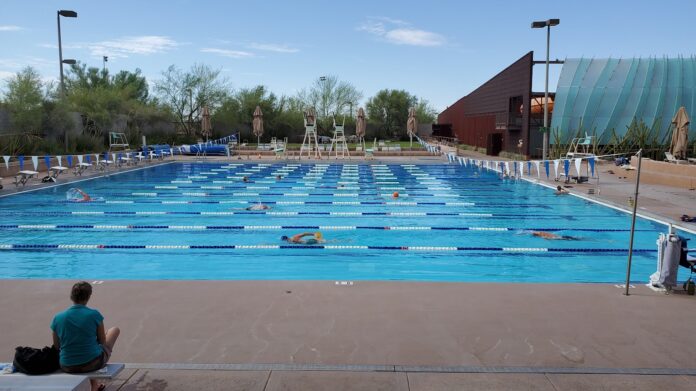I remember back when Polar was the happening heart rate monitor company back in 1996 when I first started triathlons. Their HRMs had the ability to read and transmit through the water to the watch a current heart rate value. When the 2.4Ghz bandwidth, ANT+ and Bluetooth technology took over the industry, the ability to transmit a HRM signal disappeared and athletes were no longer able to get an accurate HR reading while swimming. That’s no longer the case with the introduction of Garmin’s HRM-Swim heart rate monitor. When I heard they were being released, and that we would once again have the ability to get an accurate HR reading in the water, I was sure to pre-order one. Last week (September 2015), the bundle ($199), which contains two HR straps, the HRM-Swim and HRM-Tri, arrived. For clarification, the HRM-Swim is designed to be used for swim workouts or swim-only races, as it provides HR data only. The HRM-Tri is designed to be used both in the water and running, as it incorporates the features of the Garmin HRM-Run monitors, mainly the ability to track vertical oscillation and other running metrics.
Basically, this is how the two HRMs work while in the water. The headset of the monitor has the ability to record HR data while you are swimming. Then, when you exit the water or have both the monitor and watch above the water, the saved HR data is transmitted to the watch. This has one effect some won’t like. You can not use the new monitors to see and real time HR while in the water. I’m not exactly sure how one would do so anyways with your arms moving, but that’s the deal. What happens is that when you finish a set, or the swim leg of a race, you have to get both the watch and monitor above water at the same time for the watch to update so that you can see the HR data from the previous interval. I found it takes about 7 seconds to send and update the watch display.
I’ve used the HRM-Swim a couple of times now and here are my thoughts.
The HRM-Swim is a larger, blue version of the standard Garmin HRM. It contains a tacky/sticky substance on the inside of the monitor where it makes contact with your skin. This tacky substance and wider design is what allows you to push off the wall or swim fast and not have the monitor wiggle down to your stomach. A couple of notes about he monitor itself. It is not stretchy like Garmin’s other monitors, which makes sense in the ‘it doesn’t slip down’ area. There is one very small section of the band that allow for some stretch. This means that you have to really get the band to fit correctly. Too loose and it slides down. Too tight and you can’t breath.
The workouts I did with the HRM-Swim were basically the same. They were shakedown workouts to learn the ins and outs of the band. They both consisted of a 300-400 meter warm up. I then completed a straight 1000m swim. That was followed by 10×100 and a more aggressive pace with hard push-off from the wall to see if the band would hold.
During the 1000s, I will say that the band did not wiggle down. I did place it too tight at first. About 300 meters into the 1000, I noticed I was getting cut just under my right armpit by the band. You see, Garmin designed the band well, but not perfect. While most of the areas where the band connects to itself, Garmin placed material flaps that cover the ‘joint’ so they don’t dig into your skin. That is expect for one of the joints that sits one the left side of the monitor. By the time I was done with the 1000, I had a nice little raw spot from the rubbing. Something else I didn’t think of when I started. The band seemed loose when I first started swimming, but my the end of the 1000, when more blood was in my upper body from the exertion, the band got to be too tight and most of the rubbing occurred then.
Also, at times during the 1000, it felt like water was getting between the band and my skin and probably not allowing for a HR reading. When I finished and lifted both the monitor and watch out of the water, it took approximately 7 seconds for the data to be read from the monitor and my average HR for the 1000m interval to be displayed. It seemed about right on the face of it, but I would not know until I was able to see the whole file on Garmin Connect later.
I then moved on to the 10x100s. After the first couple I had to stop and loosen the band, as by this time the rubbing under my left arm was getting painful. After loosening it by about a 1/4 inch, my next 100 felt like the band was not making contact and if I pushed too hard off of the wall it would slide down. The remaining 7x100s were a series of trail and error to get the band to fit well. By the end I got it dialed in and the band seemed relatively comfortable, while I didn’t have to worry about it sliding down.
Both of the workouts I did were 2400 meters and, while the band was not super comfortable, it seemed to serve its purpose.
But the proof would be in the workout data once it was uploaded to Garmin Connect. Here is a view of the Garmin data:
You can see that the HRM-Swim gave consistent data. I didn’t find any real drops, even when I felt like the monitor was not making contact with my skin. I was actually surprised to see how consistent it was. Here is the Garmin Connect Workout if you would like to see the raw data.
My final thoughts are: The HRM-Swim does was it advertises. If you want to have access to your HR data while you swim, you should think about purchasing one. I think the data during races will prove to be valuable over a season. If you want to use the data during specific swims or to pace yourself, you might be disappointed. Also, I don’t think the band it comfortable enough to use during day-to-day workouts. It will probably be best to use in the pool when you are doing a test set or during a long distance set.
A final note: if you use a logging service like Training Peaks or Stava, they have not yet changed their sites to allow the view of heart rate data for swim workouts. So, if you were planning on using the data from the HRM-Swim to analyze it via Training Peaks, you are going to be disappointed. Currently, the only way to actually view the data over a workout is on Garmin Connect.

